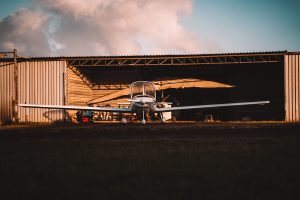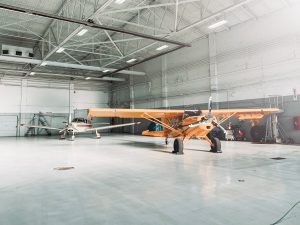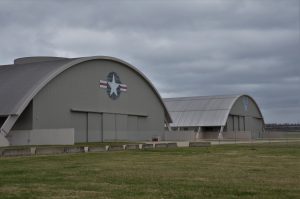If you own an airplane, you probably keep it in a hangar. You may own the hangar and lease the airport property beneath the hangar, you may lease both the hangar and the land beneath it, or you may simply lease space within a hangar that is owned/leased by a third-party. And the terms of your hangar lease will depend upon your specific leasing arrangement. In order to protect you and your aircraft, you need to pay careful attention to the terms of your lease agreement.
Here are some of the key lease terms and issues to consider when negotiating your lease:
Rent. While rent is usually one of the first terms a potential tenant considers, it can be a little more complicated than simply “how much do I pay per month?” First, the lease may require a set monthly or annual rental payment for the property. This is often referred to as “base rent.” However, this is not the bottom line for what the lease will cost. Additional fees which increase and can exceed the base rent include assessments, taxes, and license fees to name a few. It is imperative that you determine up front what additional fees for which you may be responsible and precisely how those fees are calculated. Depending upon the total of the additional fees, you may be able to negotiate the base rent amount.
 Similarly, if the lease provides the lessor with the ability to raise or decrease the rent, be sure to understand when this can happen and upon what such a change is based. Although you may not be able to control whether or not an increase or decrease in the rent is imposed, by understanding the circumstances upon which this change may take place, you will be able to plan for and possibly forecast this change in rent.
Similarly, if the lease provides the lessor with the ability to raise or decrease the rent, be sure to understand when this can happen and upon what such a change is based. Although you may not be able to control whether or not an increase or decrease in the rent is imposed, by understanding the circumstances upon which this change may take place, you will be able to plan for and possibly forecast this change in rent.
Lease Term. This provision deals with the duration of the lease. Specifically, you need to know when the lease actually starts. This may be important when new construction of a hangar, building or other improvements are involved which may prevent your use of the property until the work is completed. To obtain the fullest use of the property, you may want the actual lease term to begin when construction is completed and you are actually able to put your aircraft in the hangar, rather than making lease payments during construction even though you do not have full use of the property.
It is also important to understand how long the lease will last. Is the lease month-to-month or for a set number of months? Further, is the lease renewable? If so, will it renew automatically, or must you exercise the option of extending or renewing the lease? If you must exercise an option, make sure you know how far in advance of the lease’s termination you must give notice that you are extending or renewing the lease.
Knowing the potential duration of your lease becomes especially important in situations where the lessor does not have an obligation to renew or extend the lease. If the lease does not provide otherwise, a lessor could have the ability to not renew or extend a lease even after you have invested in building a hangar or other improvements to the property. Although this may seem unfair, the language of the lease will govern your rights. Thus, understanding this information up front is essential because it will allow you to assess the financial feasibility of recouping any investment you may wish to make in the property during the lease.
Use of the Property. The lease will likely have language specifying or limiting the types of activities for which the property may be used. Make sure the terms of the lease allow you to use the property the way you have planned. If you plan to sub-lease part of the space to another aircraft owner or intend to run some type of business from the property, you will need to ensure that the lease allows your intended use. This may be done with language which specifically allows your intended use, or with general language that will allow a wider variety of uses, including your intended use.
After you sign the lease, if the language of the lease does not allow you to use the hangar in the manner you wish, you may need to obtain permission from the lessor.
It is much easier to include the appropriate language in the lease prior to signing, rather than attempting to change the lease or obtain the lessor’s permission after the fact. Thus, you will need to have a good idea as to how you intend to use the property, both at the beginning and throughout the term of the lease.
Also keep in mind that the Federal Aviation Administration (“FAA”) has a policy on aeronautical use of hangars that applies to airports where the airport sponsor receives funds from the FAA through the Airport Improvement Program (“AIP”). If your hangar is on an airport that does not receive AIP funds, then any restrictions or limitations on use of your hangar would likely be dictated within your lease with the airport owner or operator.
However, even if the lease does not contain AIP restrictions and limitations, once the airport sponsor receives AIP grants and airport land designated for aeronautical use is made available for construction of hangars, the hangars built on the land are subject to the airport sponsor’s obligation to use the land for aeronautical purposes.
 According to the FAA, permitted aeronautical uses for hangars include:
According to the FAA, permitted aeronautical uses for hangars include:
-
Storage of active aircraft.
-
Final assembly of aircraft under construction.
-
Non-commercial construction of amateur-built or kit-built aircraft. In expanding its policy to include all amateur/kit-built construction, rather than just final assembly, the FAA recognized that “[i]t may be more difficult for those constructing amateur-built or kit-built aircraft to find alternative space for construction or a means to ultimately transport completed large aircraft components to the airport for final assembly, and ultimately for access to taxiways for operation.”
-
Maintenance, repair, or refurbishment of aircraft, but not the indefinite storage of non-operational aircraft. The FAA does not establish an arbitrary time period beyond which an aircraft is no longer considered operational. Rather, the FAA leaves it to the airport sponsor to decide whether a particular aircraft is likely to become operational in a reasonable time; and
-
Storage of aircraft handling equipment (e.g., towbars, glider tow equipment, workbenches, and tools and materials used in the servicing, maintenance, repair or outfitting of aircraft).
Non-aeronautical use within a hangar that is used primarily for aeronautical purposes, may still be permitted, provided that use does not interfere with the aeronautical use of the hangar. What does that mean? The FAA will consider certain uses to be interfering with the aeronautical use if they:
-
Impede the movement of the aircraft in and out of the hangar or impede access to aircraft or other aeronautical contents of the hangar.
-
Impede access to aircraft or other aeronautical contents of the hangar; or
-
Or if vehicles are stored in violation of the airport sponsor’s rules and regulations, lease provisions, building codes or local ordinances.


 Buildings and Construction
Buildings and Construction